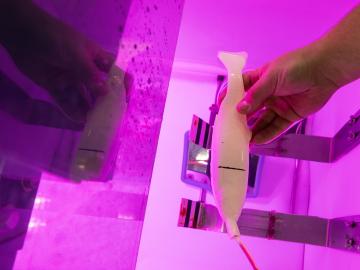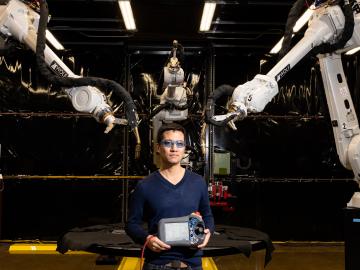
Filter News
Area of Research
News Topics
- (-) 3-D Printing/Advanced Manufacturing (29)
- (-) Biomedical (22)
- (-) Energy Storage (22)
- (-) Grid (7)
- (-) Isotopes (8)
- (-) Mercury (2)
- (-) Physics (15)
- (-) Space Exploration (2)
- Advanced Reactors (14)
- Artificial Intelligence (9)
- Big Data (13)
- Bioenergy (15)
- Biology (7)
- Biotechnology (2)
- Buildings (1)
- Chemical Sciences (5)
- Clean Water (2)
- Composites (2)
- Computer Science (45)
- Coronavirus (25)
- Critical Materials (2)
- Cybersecurity (6)
- Environment (33)
- Exascale Computing (4)
- Frontier (1)
- Fusion (14)
- High-Performance Computing (3)
- Machine Learning (8)
- Materials (2)
- Materials Science (39)
- Mathematics (2)
- Microscopy (9)
- Molten Salt (2)
- Nanotechnology (17)
- National Security (2)
- Neutron Science (38)
- Nuclear Energy (31)
- Polymers (7)
- Quantum Science (14)
- Security (3)
- Summit (17)
- Transportation (17)
Media Contacts

Hydropower developers must consider many factors when it comes time to license a new project or renew an existing one: How can environmental impacts be mitigated, including to fish populations?

A versatile class of flexible, protein-like polymers could significantly advance future drug delivery methods. But first, scientists have to develop a reliable process for tailoring these polymers into shapes that can effectively transport medicines throughout the human body.

Researchers at the Department of Energy’s Oak Ridge National Laboratory have used Summit, the world’s most powerful and smartest supercomputer, to identify 77 small-molecule drug compounds that might warrant further study in the fight

Biological membranes, such as the “walls” of most types of living cells, primarily consist of a double layer of lipids, or “lipid bilayer,” that forms the structure, and a variety of embedded and attached proteins with highly specialized functions, including proteins that rapidly and selectively transport ions and molecules in and out of the cell.

OAK RIDGE, Tenn., Feb. 19, 2020 — The U.S. Department of Energy’s Oak Ridge National Laboratory and the Tennessee Valley Authority have signed a memorandum of understanding to evaluate a new generation of flexible, cost-effective advanced nuclear reactors.

As the second-leading cause of death in the United States, cancer is a public health crisis that afflicts nearly one in two people during their lifetime.

Researchers at ORNL demonstrated that sodium-ion batteries can serve as a low-cost, high performance substitute for rechargeable lithium-ion batteries commonly used in robotics, power tools, and grid-scale energy storage.

Oak Ridge National Laboratory will partner with Cincinnati Children’s Hospital Medical Center to explore ways to deploy expertise in health data science that could more quickly identify patients’ mental health risk factors and aid in

Energy storage startup SPARKZ Inc. has exclusively licensed five battery technologies from the Department of Energy’s Oak Ridge National Laboratory designed to eliminate cobalt metal in lithium-ion batteries. The advancement is aimed at accelerating the production of electric vehicles and energy storage solutions for the power grid.

Peter Wang is focused on robotics and automation at the Department of Energy’s Manufacturing Demonstration Facility at ORNL, working on high-profile projects such as the MedUSA, a large-scale hybrid additive manufacturing machine.


